#Italian Futurist Poster Art
Text

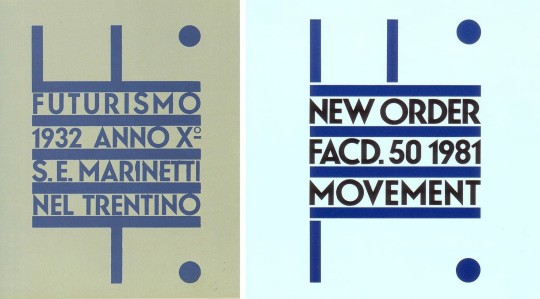

REPURPOSING ITALIAN FUTURISM FOR THE LATEST IN POST-ROCK/ EXPERIMENTAL SOUNDS.
PIC(S) INFO: Spotlight on the now iconic poster art by Italian Futurist Fortunato Depero for the 1932 exposition Futurismo Trentino, later repurposed by graphic artist Peter Saville of Factory Records for NEW ORDER's 1981 debut album "Movement."
Resolution from largest to smallest: 1479x818, 1060x1078, & 790x790.
NEW ORDER
"Movement" / FACT 50
(Factory Records, 1981)
SLEEVE ART OVERVIEW: "Already prominent in NEW ORDER's early singles "Procession" and "Everything’s Gone Green," Saville turned to Italian futurism, and specifically Fortunato Depero’s poster for the 1932 exposition "Futurismo Trentino" for inspiration. Clean lines and strong typography had been visible from 1979’s "A Factory Sample," but here Saville imbued each stroke with veiled meaning, subtly adapting Depero’s design. Putting the album’s FAC. 50 matrix number front and centre, the cover is built around the "F" for Factory and "L," Roman numeral for 50, the light blue background of the UK release chosen by the band."
-- THE VINYL FACTORY, "Tracing the art of New Order in 10 iconic record sleeves," by Amar Ediriwira, published September 24, 2015
Sources: https://mastodon.world/@Long_live_rock_n_roll/111401932429175639, Fonts in Use, The Vinyl Factory, various, etc...
#NEW ORDER#NEW ORDER band#1981#NEW ORDER 1981#Post-punk#Post punk#Fortunato Depero Art#Fortunato Depero#Italian Futurism#Futurism#Futurist#Factory Records#Peter Saville Art#1980s#Italian Poster#Futurismo Trentino 1932#Italian Futurist Art#Experimental Music#Italian Futurist Poster Art#Peter Saville#Italian Poster Art#Futurismo Trentino#Italian Futurist#1930s#Poster Art#30s#Cover Art#Sleeve Art#Graphic Design#Typography
14 notes
·
View notes
Text




vintage notebook 🛰️
This is a beautiful italian notebook right from the late 60s - it belonged to my mum. The cover says “Future World” and shows a retro-futuristic landscape, while on the back there’s a little description of what the future (year 2000) could look like.
It costed L.250 - which stands for only 14 cents
#vintage#retro aesthetic#retro futurism#retro futuristic#notebook#1960s#1970s#space#school#retro#vintage aesthetic#italy#italian#italia#vintage scifi#scifi#scifiart#retro scifi#retro style#scifi aesthetic#scifidaily#old art#vaporwave#vapor#design#graphic design#posters#poster#graphic art
2 notes
·
View notes
Text

From pasta, to men’s hats, to theater performances, to typewriters, and beyond, artists of the time applied modern aesthetics to create graphic, engaging, color-blocked posters (among other advertising materials) that not only forwarded Modernist and Futurist thinking among artistic circles into the common visual vernacular, but made advertising a form of artistic expression in its own right.
A new exhibition at Manhattan’s Center for Italian Modern Art looks at the cross-pollination between avant-garde art and commercial posters in post-WWII Italy.
33 notes
·
View notes
Text
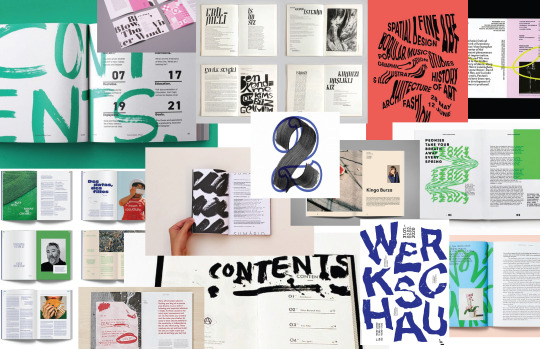

For week 10 of Typography Design, we read the textbook chapter on typography in time and motion which talks about how typographers can manipulate type by bringing in elements of motion and time such as animation and film to exchange their typography. These behaviors are actions that typographers can add to their otherwise static type a narrative component to the type and further explore the meaning and strengthen purpose in the design. The text starts off talking about the early forms of dynamic typography such as artists working in the Italian futurist movements like Filippo Marinetti who I remember studying in my art history classes as using type on diagonal and vertical bases to express how language could be liberated from the assumptions of how language could be expressed and broke from traditional typography. Other artists brought exploring uncommon language expressions into their work as well such as French poet Guillaume Apollinaire worked with “calligrams,” poems with words that move through the page to express a concept. A lot of what is talked about in this chapter really applies to my recent exploration of Adobe Aero for my immersive design poster and how we were tasked with creating a poster that would when scanned immerse the viewer in the poster itself and have some kind of animation or motion to it. When deciding what I wanted to do to add this element to my poster I played with different variations of things like time and sequence. I had to decide when I wanted my shapes to start bouncing and if I wanted them to all go at the same time or to stagger them once the movement was triggered by the viewing. I also worked to make the continuity of my motion design work as I wanted the shapes to continuously bounce so that the video didn't have a start or stop only slowly repeating itself as if the shapes bounced rhythmically up and down forever. I also manipulated the frame and space of my design as I made some layers of shapes come out towards the viewer and off the poster more than others to create depth. Since this was my first time doing anything like this I think that I could definitely have done something a little more interesting with my design or something more complex now that I have a better grasp on the program and motion design from this chapter.
In class, our last project, our process book, was introduced and I began creating my document, taking notes on layouts, and creating mood boards for my process book. Since this to me is such a huge project as it determines whether I get accepted into the Graphic Design program here and can continue forward with the major I am really daunted with where to start making my book because I feel like the pressure to make it really showcase how much I wanted to be part of the program is just really hard and it's been stressing me out more than it probably should. For my book I want to focus on typography obviously so I wanted to do something interesting for my headers and titles in the book to make it stand out and add another element of interest to my work. I was playing around with possibly manipulating type in some way such as scanning it digitally manipulating it or hand-lettering my type in a sort of messy and brushy way similar to what I did for my type in my music festival poster.
0 notes
Text

'Following Ian Curtis’ death, the remaining members of Joy Division formed New Order, taking the post-punk sound from Joy Divison but implementing more modern electronic sounds. Their debut album Movement designed by Saville directly references Italian Futurist artist Fortunato Depero and the poster for a 1932 exhibition Futurismo Trentino.
Saville thought that the names Movement and Futurism went hand-in-hand since Futurism celebrates the idea of energy, speed and modernity which relates nicely with this new style of music from the band.'
Peter Saville, New Order's Movement, 1981.
Berry, C (2017) The Art & Design of Factory Records, https://craigberry93.medium.com/the-art-design-of-factory-records-6456b9ac8112
1 note
·
View note
Photo

Mario Laboccetta
The Carthusia Capri vintage poster features a double tailed mermaid that shows the flowers and herbs used to make this ancient perfume that is produced on the Island of Capri.
Italian futurist artist Mario Labocetta designed the unique "Mermaid of Capri" logo in 1948 for the Carthusian perfumery, a business that was first founded in 1380 by the monks at the monastery of St. Giacomo on the island of Capri;
lithographer - Graphic Arts of Mauro-Cava;
Country - Italy; date - 1962;
4 notes
·
View notes
Text
Week 8 - Futurism
After watching today’s lecture, I’ve become very fond of Filippo Marinetti’s works. Marinetti grew in many different places around the world including places such as Egypt, France, Italy and Switzerland. This explained why he wrote in both French and Italian later on in life.
The poster: Parole in Libertà (freed words) by Marinetti is an important stance especially in the italian futurist movement. It radicalise the way that language is being used and its one of the first few times when type is taken on as a voice. This broke the all of the traditional ways in Western Europe in Italy, as it is considered as a sense of harmony in futurism.
Link: https://www.youtube.com/watch?v=3_3O0zOiX-w
This youtube link is to the poem he wrote about sound reproduction of the war violence during the Balkan wars in 1912-1913. In the title “Zang Tumb Tumb”, falling bombs can be already heard in the stretched vowels. Marinetti emphasises that the poem purposes were not to be read as a protest against war but he was simply impressed by the mechanical, modern and industrial warfare.

(Please Keep Reading)
QUOTES
from ZANG TUMB TUMB (1912)
“The poet must spend himself with ardor, splendor, and generosity, to swell the enthusiastic fervor of the primordial elements”
“We will destroy the museums, libraries, academies of every kind, will fight moralism, feminism, every opportunistic or utilitarian cowardice”
Filippo Marinetti in The Futurist Manifesto, translation by R.W. Flint
References:
Filipino Marinetti
https://www.khanacademy.org/humanities/art-1010/cubism-early-abstraction/art-great-war/a/italian-futurism-an-introduction
https://muurgedichten.nl/en/muurgedicht/zang-tumb-tumb-1912
https://en.wikipedia.org/wiki/First_Balkan_War
8 notes
·
View notes
Text
The Lamborghini Countach: History, Generations, Specifications

All things Lamborghini Countach on Automobile.
Lamborghini Countach Essential History
Lamborghini Countach Origins
The Lamborghini Countach was one of the last models to be built under the control of eponymous brand founder Ferruccio Lamborghini, in an effort to improve upon the comfort, eye appeal, and performance of the revolutionary Miura. In 1970, Project LP112 was the code name given to what would ultimately become the Countach, the final name chosen after a styling assistant uttered the Piedmontese term "contacc!"—an excited term of awe—upon seeing the final concept slated to debut at Geneva in 1971.
Nevertheless, it would take until 1974 for the production Countach LP400 to finally be ready. By then, Ferruccio Lamborghini's finances were looking dim, having both his tractor business and Lamborghini Automobili as well. He retired to the country to produce wine, while Lamborghini's new owners struggled to make the Countach a sales hit. By 1980, Lamborghini Automobili was in bankruptcy. When new owners came into the picture in 1982, the Countach was finally federalized for U.S. sales—a market that would come to be the automaker's largest.
Lamborghini Countach Evolution
Through the years, the Countach was continually evolved. The earliest 1974 models, known as "Periscopio" for their unique periscope-style rear-view mirror setup, are the purest from a styling standpoint, without the cacophony of scoops, vents, wings, and flares that would come to epitomize the later cars. A Bizzarrini-designed 3.9-liter V-12 engine produced roughly 375 hp in a relatively light tubular space frame chassis designed by Paolo Stanzani. The frame was covered by striking wedge-shaped bodywork with futuristic scissor doors as styled by Marcello Gandini while at Bertone.
In 1978, the Countach LP400 S was introduced. Here we begin to see the styling take on extra flash with wider fender flares, wheels, and tires, and the introduction of the Countach's iconic and gargantuan V-shaped rear wing. Engine capacity was increased in 1982 to 4.8 liters, resulting in another name change to Countach LP5000 S.
Lamborghini Countach Final Years
For 1985, the Countach LP5000 QV was introduced, QV standing for "quattrovalvole," or four-valve in Italian. True to its name, the now-5.2-liter V-12 was given a four-valves-per-cylinder head for increased efficiency, as well as another bump in output to 455 horsepower when equipped with six downdraft Weber carburetors (leading to these being commonly known as "Downdraft" cars), or 415 horsepower with the Bosch fuel injection U.S.-market cars received to meet Federal emissions standards. American-spec cars also got larger, heavier impact bumpers than their European counterparts. Arriving in 1988, the 25th Anniversary Edition Countach received an even more outrageous restyle by Horacio Pagani, who would go on to form his very own supercar company some years later. With an excess of dramatic styling strakes over gaping ducts and airfoils, the 25th Anniversary Edition Countach was often seen as a tribute to 1980s excess as well as a caricature of the earliest Periscopio models. The Countach was finally discontinued to make way for the Diablo in 1990.
Lamborghini Countach Highlights
Although the Lamborghini Countach was unquestionably one of the premiere performance cars and styling sensations of its day, that still wasn't good enough for some elite enthusiasts. When Walter Wolf, owner of Formula 1 racing team Wolf F1 Racing, took delivery of his LP400 in the mid-1970s, he decided the car wasn't up to his expectations. Back it went to Lamborghini where a special 447-horsepower 5.0-liter V-12 went in the mid-mounted engine bay, while special styling modifications—including large fender flares and a rear wing—would foreshadow changes later made to the production Countach.
Additionally, while Ferruccio Lamborghini was famously uninterested in motorsports (costing him the employment of Gian Paolo Dallara as chief engineer), the Countach was used as the official safety car for the 1980-'83 Monaco Grand Prix Formula 1 race weekend.
A Countach Evoluzione prototype was built by Lamborghini around 1987, which essentially served as an engineering exercise ahead of the development of the Countach's successor, the Diablo. This car heavily featured composite materials in its construction, had a unibody chassis which replaced the previous steel tube frame, and incorporated various aerodynamic improvements, some of which would be seen on the 25th Anniversary Edition of 1988-'90. An all-wheel drive powertrain was also tested, a nod to the all-wheel-drive Diablo variants to come. The single Countach Evoluzione that was built is no longer in existence.
Lamborghini Countach Buying Tips
Lamborghini Countach values have swung wildly through the years. They hit rock bottom in the late 1980s and early 1990s, when many examples could be found for well under $100,000, but since then, and particularly in the past decade, values have ramped up yet again. Today, you'll pay the most for the rare, earliest "Periscopio" models for their clean design that best shows the car's original Gandini-penned vision. Conversely, the final 25th Anniversary Edition models have historically not been very desirable with their myriad tacked-on styling functions. The most popular models are typically the 5000 QV cars, which hit a sweet spot in styling, refinement and performance.
Lamborghini Countach Articles On Automobile
Wall Art Comes Alive: We Drive a 1986 Lamborghini Countach QV "Downdraft"
All these years later, the Countach is still the stuff of dreams.
Collectible Classic: 1974-'90 Lamborghini Countach
The Countach through the years.
Ferrari Testarossa vs. Lamborghini Countach
Two exotic supercars sold a million posters and are reunited.
Bertone Treasures For Sale in Bankruptcy Auction
The firm that designed the Countach still has some original parts.
How Much Is It? A Historical Timeline of Lamborghini Prices
See how the Countach ranks in value among its bullish peers.
Lamborghini Countach Recent Auctions
1975 Lamborghini Countach LP400 "Periscopio"
1979 Lamborghini Countach LP400S
1984 Lamborghini Countach LP500 S
1988 Lamborghini Countach 5000 QV
1989 Lamborghini Countach 25thAnniversary Edition
Lamborghini Countach Quick Facts
First year of production: 1974
Last year of production: 1990
Total sold: 1,983
Original price (base): $72,200 (1974)
Characteristic feature: The seminal supercar, the Lamborghini Countach is as much a dream drive today as it was when first launched nearly 50 years ago.
Lamborghini Countach FAQ
● Why Are Lamborghini Countach So Expensive?
It's all about supply and demand. The Countach is a car that transcended car culture, venturing into pop culture. Because of this, the car's wild styling made it popular worldwide, but with under 2,000 built, there are only so many people that can own one. Besides that, the Countach is a special and highly significant supercar—another factor that helps keep values high.
● How Many Lamborghini Countaches Are Left?
The Countach hails from a time when even advanced supercars didn't have electronic driving nannies to keep them on the road when driver input fails. As a result of this and their relatively high level of performance, you can bet that many were written off, never to be rebuilt. That said, high values mean it takes a lot of damage to total a Countach, meaning many cars have been salvaged into running, driving cars. We suspect that at least 1,500 Countach models still exist.
● How Much Is A 1989 Lamborghini Countach?
A 1989 Lamborghini Countach 25th Anniversary Edition is worth an average of $240,000 according to Hagerty. Early "Periscopio" cars can bring over $1 million, while a good 5000 QV from the mid-1980s is worth an average of $400,000. ทีเด็ดบ้านผลบอล
Contact us by Line ID: @ufa98v2
#ทีเด็ดบ้านผลบอล#ทีเด็ดบอลวันนี้#ทีเด็ดฟุตบอล#ทีเด็ดบอล#ทีเด็ดบอลคืนนี้#ทีเด็ดบอลชุด 4 ตัว#ผลบอลสด#บ้านผลบอล#ผลบอลเมื่อคืน#ผลบอลสดทุกลีก#ผลบอล#ตารางบอล#ราคาบอลไหล#ราคาบอล#ตารางบอลวันนี้#วิเคราะห์บอล
2 notes
·
View notes
Photo
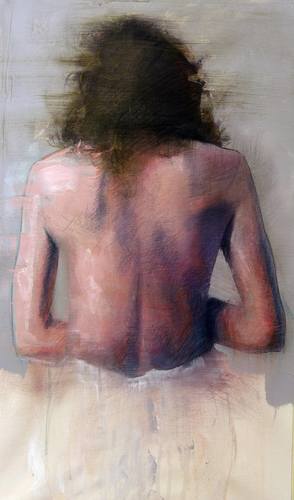
Hyperbolic shades 15, Dario Moschetta
Acrylic anda pastels on canvas 40x68cm From thsart magazine interview: Let our readers know who you are, where you are from and what kind of art you create? My name is Dario Moschetta and I am an artist of Castelfranco Veneto, a small town near Treviso, Italy. I was born here and worked the Renaissance painter Giorgione. My job is to make paintings in acrylic, I’ve been experimenting with various techniques developed by me, one of them is to apply several layers of paper and tear it in a controlled manner, so as to obtain a surface irregular, such as posters of movies that you can see in the street. those are the big city skyline in general. I also do portraits and nudes, even of large size. Show & Tell us about your workspace and the tools you use. (brushes, charcoal, steel, lasers?) Use canvas roll, I need a big white surface, when the work is finished I choose the right size. so I feel free to work. I like acrylics because it gives me execution speed, and can be corrected at any time. Brushes of medium size. I also use spatulas, knives, sandpaper, spray water, and step on the surface rags and more. Everything is instinctive, without a precise logic, when something goes well, do not touch it anymore. What is your favourite piece of art from another artist? There are many artists that I like, I can say here Fracis Bacon, Lucian Freud. further into the past, Modigliani, Picasso, but also the impressionists, italian futurists. if I had to pick one right now … a Bacon self-portrait....
https://www.saatchiart.com/art/Painting-Hyperbolic-shades-15/337243/2649431/view
1 note
·
View note
Text
Munich International Motor Show : Now in eco mode

The International Motor Show in Munich has begun this Tuesday. Instead of models in front of sports cars, the providers are now presenting recycled cars and bicycles. This should underpin the change in the industry - but by far not everyone likes it.
If one last proof was needed that the German auto industry really wants to do everything completely different now, then it is this, well, airy demonstration. In the coming week, the International Motor Show, better known as the IAA[1], begins in Munich. And the Association of German Automobile Manufacturers, the VDA, [2] has invited the reporters to a preview - but not by bus or in an electric car convoy, but by zeppelin.
At a height of 500 meters you will glide gently over Munich and see how what how this probably most important German trade fair has changed. The IAA no longer only takes place in exhibition halls, but also right in the middle of the old town: at Königsplatz, for example, at Odeonsplatz, at Stachus or Marienplatz and also on the A 94 autobahn where people can try out futuristic vehicles.
In the past, the bigger the better
The change of perspective is necessary. Everything used to be clear, the rule of thumb was: the bigger, the better. Business is still running according to these rules - extremely well in fact, following current sales and profit figures. But in times of lightning-fast computers, threatening climate change and overcrowded cities, the managers in Wolfsburg, Munich and Stuttgart are increasingly discussing other things, sometimes with an anxious tone: Which robot car will come from the USA tomorrow? Which new competitor is behind the corner in China? What new forms of transportation are in demand? How green do you have to get? And yes, that too: How desirable are you actually?
When the industry gathered for the last time at the IAA, in autumn 2019, already a lot of certainties for so long in the automotive world had been shaken. And the car people hardly had any answers. This is one of the reasons why the IAA 2019 in Frankfurt turned out to be quite a disaster - which is not an exaggeration - that should not be repeated.
When Chancellor Angela Merkel visited, climate activists grimly climbed some cars and held up posters: "Climate killers". The BMW employees stood around their occupied cars, perplexed. The dented roofs were the smallest problem. The managers simply didn't know how to deal with this situation, for which there is probably no good solution. Halligalli [3] was also outside the gates: demonstrators blocked the driveway with bicycles. Which, by the way, was quite right for the mayor of Frankfurt, Peter Feldmann. The SPD man - after all, actually the host - was not allowed to speak at the opening. His speech was then of course known anyway: "Frankfurt needs more buses and trains, but not more SUVs," it said. And he also thanked the demonstrators - their fight for a better climate is important.
From then on, the disturbed car people only wanted to get away from Frankfurt. Eventually they agreed on Munich. Here, too, urban society does not embrace the auto industry. But it is probably the safest big city in the world, a main argument when looking for a new venue. "Here there are cavalry squadrons and, in case of doubt, a stable police cauldron," said someone from the industry who was involved in the decision-making process some time ago. But that alone is not enough to make the trade fair a success again.
Because the car itself has lost traction. In Frankfurt there were only a good 500,000 visitors. Half as many as a few years earlier. Even in this area of life, providers and consumers have migrated to the Internet. And the avant-garde is somewhere else anyway: Google, Apple and Tesla are leaders in robot functions and electromobility - and what are the Chinese actually building with massive state support? Hardly any of this could be seen in Frankfurt.
The big trade fairs were long regarded as high masses: the car show in Geneva or Paris, the motor show in Detroit - or the IAA in Frankfurt, that was glamor in all its facets. Whoever could went there. The others at least devoured the reports and photos about horsepower cars and the scarcely clothed young women that manufacturers like Ferrari put on hoods, which they thought was creative.
It was the time when car managers secretly hung around the competition's exhibition halls, sometimes more, sometimes less, to see what their colleagues were up to. When they met in the back rooms of the pavilions to make deals and start mergers. When men like the former Daimler boss Dieter Zetsche and the long-time Renault-Nissan boss Carlos Ghosn sat on the big stage, talking about cars, marriages and all sorts of other things and the audience wondered whether what took place was more of a cabaret . Ghosn later got into trouble with the Japanese judiciary and at some point fled to Lebanon in an instrument case. Behind the big cars was often also a perfectly staged drama.
The VW family owners made the managers act like gladiators in the Coliseum
In all these years, however, nobody had encouraged the knighting of the car more than Volkswagen. On the eve of the official car show openings, the Wolfsburg always invited people to a large hall, in Frankfurt, in Paris, in Geneva, regardless of the main thing: big. When every brand boss then presented his latest models in front of the big players, the music came off the tape at discotheque volume, when the bosses of Porsche, Audi and Skoda bowed to the powerful, the family owners Wolfgang Porsche and above all Ferdinand Piëch, then this copied Roman Coliseum-style events: Ave, Caesar, morituri te salutant.
It was loud on those evenings in the VW Coliseum, very loud. Sometimes the Pet Shop Boys performed, sometimes the French film diva Catherine Deneuve, sometimes rope artists and dancers. Each act was kind of out of place in its own way. But these evenings weren't about the total work of art being convincing. The names were important. The celebrities. And the volume. When the twelve cylinders of the Lamborghini Aventador also cracked to the pounding techno music, to light shows and artificial fog, then you wondered how - for example - Mr Piëch, who was already older at the time, could stand it. Mostly he sat there, stoic, immobile, absent.
As soon as the show was over and the gladiators bowed to him, the emperor stood up and left the stands. Walked slowly down the stairs into the arena. Pretended to be inspecting cars, but the truth was he wanted to speak to the people, and so he did. Often only a few minutes, but that provided a topic of conversation for days. For example, when he said between half sentences that he would like to buy the Fiat subsidiary Alfa Romeo. Just like that, maybe also to drive the then Fiat boss Sergio Marchionne to white heat. Incidentally, the latter took revenge a few years later. When the Germans sank into the diesel scandal and Fiat was accused of having also manipulated diesel engines, the Italian said: "Anyone who compares us with the German company has smoked something illegal."
The "i Vision Circular" should consist of almost 100 percent recycled material
Perhaps the diesel scandal was the beginning of the end of the big trade fairs, in any case it accelerated change. As a result of the crisis, the evitably oversized cars were trimmed down to normal. At the same time, new competitors with new technologies pushed into the industry. Then Piëch and his top managers disappeared from the scene. And the new managers also break the existing professional rules. At the IAA 2019 VW boss Herbert Diess tried out the embrace technique with the demonstrators, he went almost completely out to the people, discussed with an activist of the "Sand im Getriebe"[4] initiative. That was a bit obnoxious on his part, but at least he had tried it.
Nowadays even in Munich, they want to appear more modern here and everything should run more smoothly, the industry hopes. And other content has been agreed. In particular, visitors can see electric cars, such as a stretchable sedan from Audi. And BMW wants to talk about the circular economy in its "Joytopia": How can mobility function in a resource-saving and low-CO₂ manner? The company wants to present the "i Vision Circular", a vision vehicle that consists of almost 100 percent recycled material - and is designed in such a way that it can be easily recycled. VW, in turn, would like to introduce the "New Auto", the robot driven car of the day after tomorrow. "Mobility is a basic human need - and fulfilling it in all its facets is an ever greater challenge for our society, which business and politics have to face," says VDA President Hildegard Müller and is certain that the "new IAA " will show ways how these mobility tasks can be combined:" efficiently, economically, socially and ecologically ".
It should be possible to experience it in the literal sense of the word, which is why the IAA no longer takes place in noisy, stuffy exhibition halls for the most part. But outside in the squares. Because that's where the industry wants to get into conversation with critics, at least in theory - as long as they don't trample on the roofs of cars.
A pleasant approach. The corona epidemic could destroy some of it. The incidence is rising again, now fences have to be put up around the scenes in the city. So this time there is an inside and outside, which will lead to conflicts, especially since a number of initiative-takers have announced protests and rather do not want to debate in the chair, from the anonymous alliance "Smash-IAA"[5], whose posters are hanging all over the city, to the Greens Youth[6]. Many criticize the car industry for promoting its event as a green mobility fair.
The critics are not entirely wrong. Because there are also those in industry who are unfamiliar with the new IAA concept, which wants to unite everything that rolls. We are car manufacturers and should just display our cars nicely instead of having to take buses, trains and car sharing as well, they say behind closed doors. These orthodox do not think much of the fact that bicycles are now also exhibited at the "new IAA", although some car manufacturers now offer them themselves. They can't do much with expert panels on "Smart Cities", instead they complain that the IAA is not international enough, which is probably due to the Corona epidemic. In fact, even VW is not represented with all brands, Peugeot, Opel, Fiat, Volvo, Honda and Toyota completely save themselves the appearance, even expensive super sports cars will not be on display, not even the US company Tesla, which will soon have a plant in Germany opened. The German competition is afraid of the Americans, but they also know that Tesla would attract people, potential customers for everyone.
Or should bigger things be negotiated after all, the transport turnaround, climate protection? It depends on who you ask. The car people are not in agreement. The IAA 2021 is a very exciting large-scale experiment in an industry that is currently having to find itself anew. And which sometimes relies on the tried and tested. On Sunday - after the Zeppelin flight - there is a VW break in the Isarpost[7]. A large hall, there is probably loud music, and of course wine and beer, Corona or not. As always. Because as exciting as everything is right now - it would be more convenient if everything stayed the same.
Source
Thomas Fromm & Max Hägler: Jetzt mal im Öko- Modus, in: Süd-Deutsche Zeitung, 3-09-2021 https://sz.de/1.5400871
[1]die Internationale Automobilausstellung
[2] The Verband der Automobilindustrie e. V.(German Association of the Automotive Industry) is a German interest group of the German automobile industry, both automobile manufactures and automobile component suppliers. It is member of the European Automobile Manufacturers Association (ACEA). The VDA represents carmakers including BMW, Volkswagen, and Mercedes-Benz parent Daimler but also counts foreign suppliers and foreign-owned carmakers like Opel among its members. The group is located in Berlin, Germany.
[3] Halli Galli is a crowd awareness game for two to eight players.
[4] Sand in the Gears; https://sand-im-getriebe.mobi/ Sand in the gears is an action alliance made up of various climate, transport and globalization-critical groups and was founded in early 2019. It sees itselve as part of the global movement for climate justice.
[5] https://smashiaa.noblogs.org/ The International Motor Show (IAA for short) will take place in Munich from September 6 to 12, 2021. In the midst of the climate crisis, the large automobile companies want to celebrate private transport and hide what we all actually know under a green cloak: that they fuel the climate crisis for their profits. We don't want to leave that unchallenged. That is why we call for direct campaigns during the fair!
[6] https://gruene-jugend.de/
[7] https://isarpost-eventlocation.de/
0 notes
Text
(READ-PDF!) Design as Art D.O.W.N.L.O.A.D. PDF
Design as Art

[PDF] Download Design as Art Ebook | READ ONLINEhttp://read.ebookcollection.space/?book=0141035811
Author : Bruno Munari
Publisher : Penguin Classics
ISBN : 0141035811
Publication Date : 2008-9-25
Language : eng
Pages : 224
To Download or Read this book, click link below:
http://read.ebookcollection.space/?book=0141035811
[Free Ebook]
Synopsis :
One of the last surviving members of the futurist generation, Bruno Munari's Design as Art is an illustrated journey into the artistic possibilities of modern design translated by Patrick Creagh published as part of the 'Penguin on Design' series in Penguin Modern Classics.'The designer of today re-establishes the long-lost contact between art and the public, between living people and art as a living thing'Bruno Munari was among the most inspirational designers of all time, described by Picasso as 'the new Leonardo'. Munari insisted that design be beautiful, functional and accessible, and this enlightening and highly entertaining book sets out his ideas about visual, graphic and industrial design and the role it plays in the objects we use everyday. Lamps, road signs, typography, posters, children's books, advertising, cars and chairs - these are just some of the subjects to which he turns his illuminating gaze.How do we see the world around us? The Penguin on Design series includes the works of creative thinkers whose writings on art, design and the media have changed our vision forever.Bruno Munari (1907-1998), born in Milan, was the enfant terrible of Italian art and design for most of the twentieth century, contributing to many fields of both visual (paint, sculpture, film, industrial design, graphics) and non-visual arts (literature, poetry). He was twice awarded the Compasso d'Oro design prize for excellence in his field.If you enjoyed Design as Art, you might like John Berger's Ways of Seeing, also available in Penguin Modern Classics.'One of the most influential designers of the twentieth century ... Munari has encouraged people to go beyond formal conventions and stereotypes by showing them how to widen their perceptual awareness'International Herald Tribune
0 notes
Text
Expression of Speed
The fascination of speed within the art and design community came from the invention of trains, planes and automobiles. The Italian futurists were amongst the most fascinated by this concept. Edward McKnight Kauffer was one of the main graphic designers that payed homage to speed. In Kauffer's poster "Flight", 1916, Kauffer was heavily influenced by Futurists. He combined abstraction with naturalism. After him, many designer tried attempting to convey speed throughout graphic design. One of the most common ways of showing 'static' speed is through arrows. Having two or more arrows generally convey competition, acceleration and momentum.
Below shows Kauffer's "Flight" poster:

Source: Image
(from: "The Language of Graphic Design", Richard Poulin)
I was inspired by this work and how it used abstraction mixed with naturalism. After researching into abstraction I thought it was interesting to see that abstraction helps convey movement.
This concept is something I believe we can play with through the use of geometric shapes and abstract compositions.
0 notes
Photo

Louise Fili active 1975-current
An Italian American Graphic Designer enthralled by the Italian culture.
Her love for design started at a young age where she had taught herself calligraphy and illuminated manuscripts of Bob Dylan to sell to her classmates she then attended Skidmore college studying studio art,interned at the Museum of Modern Art whilst finishing her studies at the school of Visual Arts.
She worked with Random House a book publishing business for 11Years then becoming an Art Director for Pantheon books where she designed upto 2000 book jackets each with their own unique design exploring historic typography combined with modern colours and compositions.
Louise Fili took her inspiration from her love of Italy, Modernism, Art Deco styles and the Italian posters created by A.M Cassandre,Jean Carlu and Lucian Bernhard.
She collaborated with her husband author Steven Heller and also opened her own studio Louise Fili Ltd in 1989 specializing in restaurant identity food packaging and books where she continues to create Italian inspired designs.
She has taught for over twenty years at the School of Visual Arts,New York university and cooper union she also visits Rome every summer to do a SVA masters workshop and has achieved numerous medals in achievement awards.
her creation of three fonts Mardell, Montecanini and Marseille.
Marseille influenced by Art Deco with six weights
Montecanini is inspired by the early 1900s stile liberty posters.
Mardell is an Italian Futuristic style made from cut wood to print.
0 notes
Text
Umberto Boccioni
Umberto Boccioni(1882-1916) was an Italian painter and sculptor who helped in the formation of the futurist movement. He studied art at Scuola Libera del Nudo under Giovanni Mataloni, a Liberty style poster artist. He was known for being rebellious and critical, as well as having a high intellectual ability which contributed to the creation of Futurism. He focused on studying the classic Impressionist style but when he became a student of Giacomo Balla, he developed more modern methods of painting(Divisionism). After meeting Filippo Tomasso Marinetti, Boccioni signed the ‘Manifesto of Futurist painters’ in 1910.
Boccioni initially focused on drawing and painting landscapes/portraits, his mother was a frequent model, in a Impressionist or Pointillist style. He moved on from this to paint in the futurist style which he helped develop. In his works he would deconstruct solid masses and create a sense of dynamism. He aimed to capture the movement and speed of the modern world and has said,
"While the impressionists paint a picture to give one particular moment and subordinate the life of the picture to its resemblance to this moment, we synthesize every moment (time, place, form, color-tone) and thus paint the picture.”
He was criticised heavily for his work at first but it grew in popularity.
‘The City Rises’(1910) is seen as one of the first truly Futurist painting. When talking about this work to a friend he said, "I attempted a great synthesis of labor, light and movement". Although realistic elements are present in the painting, it is still rendered through perspective. The painting depicts the construction of several buildings and also contains some men on horses. He aimed to showcase the importance of the work force and modern towns and cities. Movement is depicted through the blurred figures of a horse and the men chasing after it.

0 notes
Text
WEEK 8 LECTURE - WHEN DID THE FUTURE BEGIN?
Following on from last week’s lecture on Bauhaus, a movement that focused on looking towards the past to pre-modern, came the forward thinking embrace of modernity, Futurism.
“The future becomes an IDEA... something to strive for.”
BAUHAUS VS FUTURISM
Whilst Bauhaus teachers and creatives were more traditional in their rules, Futurists were the hipsters of the early 20th century, consisting of designers who wanted to break all of the traditions that had been seen up until then (early 1900s), particularly in Western Europe (Italy).
Andy and Karen showed us numerous examples of communication design posters of the Bauhaus movement, making use of every space and material they had, with type crawling out and wrapping around other elements (the equivalent to the type on a path tool on Adobe Illustrator). Whilst Futurist designers liked to give shape to their type like that of Bauhaus, they wanted to further expand on this idea and give their type a voice, as if the letterforms were moving.
At the commencement of the lecture, Andy discussed how graphic designer, Jan Tschichold valued photography as a medium for illustration, in contrast to the Futurism movement where paintings could express the lived experience. They believed that this medium was able to show a sense of time and speed as well as advocating that when you capture moments with your eyes, you may not see them the same way that a camera does. This was interesting to note as I never thought about looking beyond capturing the image that was in front of us, but also adding our own imagination on top of it to combine dreams and reality.

Andy and Karen introduced us to some of Bruno Munari’s work, specifically his design work for publication, Almanacco Letterario Bompiani. The spreads on each page featured very interesting collage work in that they contrast between black and white photographed artefacts alongside Italian Prime Minister at the time, Benito Mussolini peaking through each page. The top left and right are keyholes where the viewer can see Mussilini’s profile, showing his connection to the images below as if he’s being critical and commenting on each of them. This not only gives voice to the elements in the spread by showing association of images, but provides humour for the reader. It takes him out of his context, showing how his decisions influence the population and how he is removed from them. Munari combines trends and themes of contemporary art and literature to the attention of his expert audience.
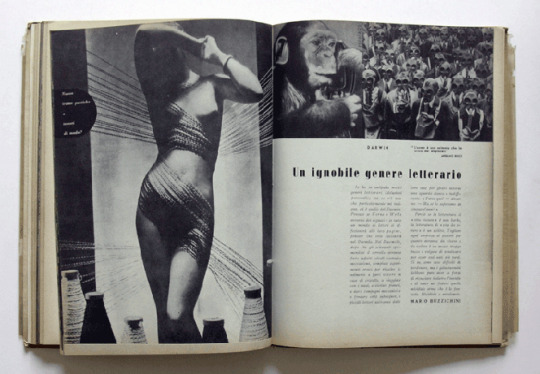
IMAGES:
Pages from 1937 “Almanacco antiLetterario”
1. https://www.italianways.com/wp-content/uploads/2014/06/IW_AlmanaccoAntiLetterario_06.jpg
2. https://www.italianways.com/wp-content/uploads/2014/06/IW_AlmanaccoAntiLetterario_07.jpg
0 notes
Text
MANIFESTO LAUNCH
Red Alan's Manifesto by Grayson Perry, 2014
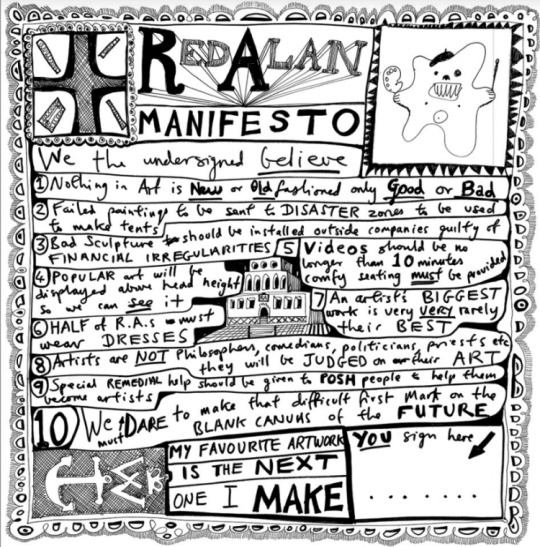
Poetry | Political Statement
Possibly Gender Fluid
Documentaries
Write a Manifesto - Create Poster
Manifestos are usually written in a group
Political Ethos
Gender Issues
ASSESS WHAT IS IMPORTANT TO YOU - what do I want to say within my art
A manifesto is a public declaration, often political in nature, of a group or individual’s principles, beliefs, and intended courses of action.

10 game-changing art manifestos
By Harriet Baker (Royal Academy)
Published 10 April 2015
Some time between 1966-76, Richard Diebenkorn wrote ten notes on beginning a painting. Described by the critic John Elderfield as a set of “artistic intentions,” they are a valuable insight into the mind of the artist, revealing some of the ways that Diebenkorn challenged himself in his work. Diebenkorn, of course, was not the first artist to lay out his beliefs. From Joshua Reynolds’s lofty Discourses to the impassioned manifestos of the early 20th-century’s avant- garde, artists have laid out pages of their visions for art, many of which changed the course of art history. And while contemporary artists continue to set their objectives on paper, it is often done with a more wry and humorous touch. The result is a collection of imperfect but fascinating ideas about what art should be.
Discourses on Art, Sir Joshua Reynolds,
1769-1790
I wished you to be persuaded, that success in your art depends almost entirely on your own industry; but the industry which I principally recommend, is not the industry of the hands, but of the mind... We may go so far as to assert, that a painter stands in need of more knowledge than is to be picked off his pallet, or collected by looking on his model, whether it be in life or in picture. He can never be a great artist, who is grossly illiterate... He ought to know something concerning the mind, as well as a great deal concerning the body of man.
Sir Joshua Reynolds PRA, Discourses VII, 1769
Sir Joshua Reynolds, Self-Portrait as a Figure of Horror, c.1784
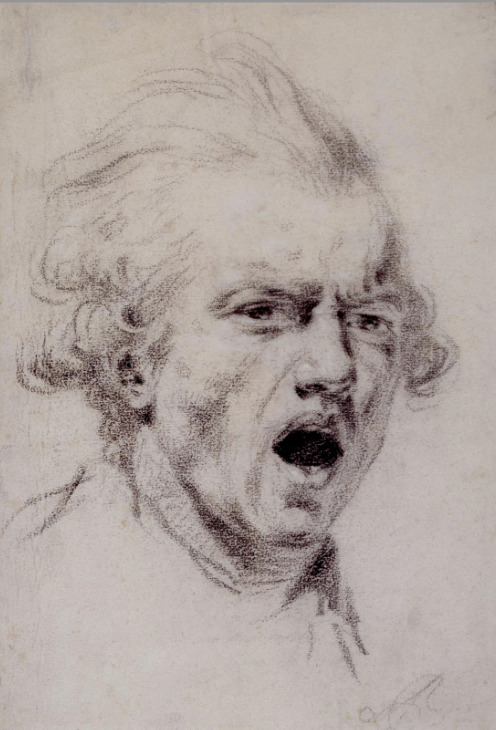
Reynolds Discourses on Art, now considered to be the founding text of British painting theory, elevated art as an activity of the mind, not the hand, and called on painters to imbue their work with much more than simply what they saw in front of them.
The Discourses were very influential, but controversial too; William Blake annotated his copy furiously, noting his “indignation and resentment” at Reynolds’s ideas, while the Pre-Raphaelites accused Reynolds of ignoring the truth in favour of ideal beauty.
ART HISTORY
The Founding and Manifesto of Futurism, FT Marinetti, 1909
1. We intend to sing the love of danger, the habit of energy and fearlessness.
2. Courage, boldness, and rebellion will be the essential elements in our poetry.
3. Up to now, literature has extolled a contemplative stillness, rapture and reverie. We intend to glorify aggressive action, a restive wakefulness, life at the double, the slap and the punching fist.
F.T. Marinetti, 1909
THE FUTURISTS
The Futurists published a huge number of different manifestos, using them to communicate their aesthetic, political, and social ideals. The scale with which the Futurists created and disseminated their manifestos was unprecedented, allowing them to transmit their ideas to a wider audience.
Many Italian Futurists supported Fascism and parallels can be drawn between the two movements. Like the Fascists, the Futurists were strongly patriotic, excited by violence and opposed to parliamentary democracy. When Mussolini took power in 1922 it brought Futurism official acceptance, but, later, this adversely affected many of the artists as they became tainted by association.
The Art of the Manifesto (or Art Manifestos)
By Eulàlia Iglésias
“We want to sing the love of danger, the habit of danger and of temerity.” Thus begins the Futurist Manifesto that Filippo Tommaso Marinetti published in French newspaper Le Figaro on February 20th, 1909.
A spectre haunted European art during the first years of the 20th century. Imbued with the spirit of the new age, fascinated by the technological innovations shown in different fields, and sympathisers of the many social and political revolutions that were arising throughout the continent, a generation of youngsters decided to break with the academic legacy and canon in force since the Renaissance to create art more in harmony with their own times: the avant-gardists. And the way to proclaim this new art was through the use of manifestos.
Up to Marinetti’s, manifestos had been circumscribed to the political sphere. By putting pen to
paper to define their intentions and affinities, these young artists declared the pragmatic character of the avant-garde. They created and destroyed in order to show their rejection of tradition and their longing to change life and transform society. The term ‘avant-garde’ has a clear military connotation, and manifestos were a war declaration of sorts against the world as they knew it.
Futurism was an Italian art movement that aimed to capture the dynamism and energy of the modern world in art. The Futurists were well versed in the latest developments in science and philosophy, and particularly fascinated with aviation and cinematography.
Futurist artists denounced the past, as they felt the weight of past cultures was extremely oppressive, particularly in Italy.
The Futurists instead proposed an art that celebrated modernity and its industry and technology.
Elasticity (detail), (1912), Umberto Boccioni.

Unique Forms of Continuity in Space (1913), Umberto Boccioni

Giacomo Balla Abstract Speed, The Car has Passed 1913

Mario Sironi’s 1918 drawing ‘Uomo Nuovo’ (New Man)
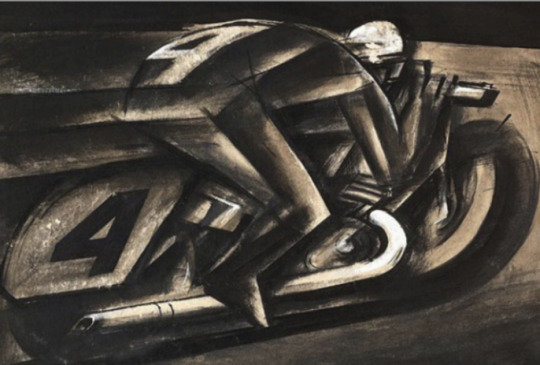
Jacques-Henri Lartigue, 1913

László Moholy-Nagy Light Prop for an Electric Stage

László Moholy-Nagy- Dual Form with Chromium Rods

As early as 1922, László Moholy-Nagy (1895–1946) began to make metal sculptures. He believed that new materials called for a new kind of art, and metal was appealing for its connection to industry and modern machinery.
Dada manifesto, Tristan Tzara, 1918
Tristan Tzara was a French poet and essayist, famous for founding Dada in Zurich in 1916 and writing the founding manifesto.
Spanning a wide variety of mediums and forms – from photography and performance art to painting and collage – the Dada movement was born out of a reaction against nationalism and rationalism, which these artists believed to have caused the First World War.
Though the movement was far from coherent, its key figures – including Hans Arp, Kurt Schwitters and Hannah Hoch – produced highly political and irreverent works influenced by Cubism, Futurism and Constructivism.
Jean Hans Arp, bois gravé et collage pour la couverture de Dada 4-5, 1919
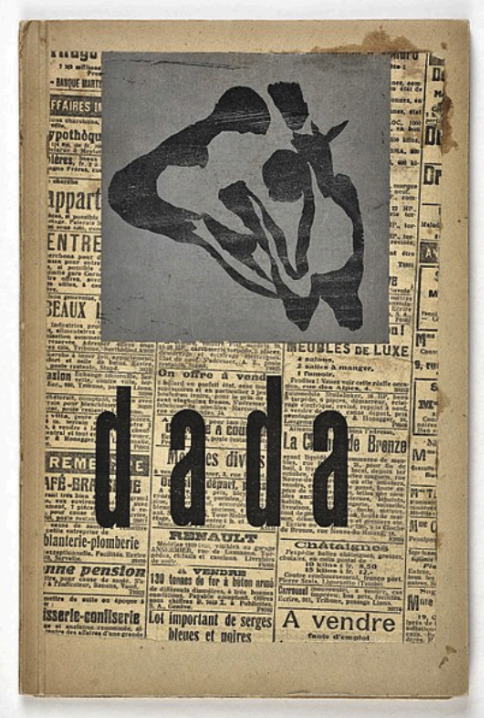
Hannah Höch
Known for her incisively political collage and photomontage works, Dada artist Hannah Höch appropriated and rearranged images and text from the mass media to critique the failings of the Weimar German Government.
Höch drew inspiration from the collage work of Pablo Picasso and fellow Dada exponent Kurt Schwitters, and her own compositions share with those artists a similarly dynamic and layered style.
She rejected the German government, but often focused her criticism more narrowly on gender issues, and is recognized as a pioneering feminist artist for works such as Das schöne Mädchen (The Beautiful Girl), (1920), an evocative visual reaction to the birth of industrial advertising and ideals of beauty it furthered.
Hannah Höch, Das schöne Mädchen (The Beautiful Girl), (1920)

Hannah Höch, Für ein Fest gemacht (Made for a Party) 1936

Hannah Höch, Cut with the Dada Kitchen Knife through the Last Weimar Beer-Belly Cultural Epoch in Germany, 1919

Man Ray, Rayograph, 1922

Man Ray. Untitled Rayograph, 1922.

Surrealism was an artistic, intellectual, and literary movement led by poet André Breton from 1924 through World War II. The Surrealists sought to overthrow the oppressive rules of modern society by demolishing its backbone of rational thought. To do so, they attempted to tap into the “superior reality” of the subconscious mind. “Completely against the tide,” said Breton, “in a violent reaction against the impoverishment and sterility of thought processes that resulted from centuries of rationalism, we turned toward the marvellous and advocated it unconditionally”.
Many of the tenets of Surrealism, including an emphasis on automatism, experimental uses of language, and found objects, had been present to some degree in the Dada movement that preceded it. However, the Surrealists systematized these strategies within the framework of psychologist Sigmund Freud’s theories on dreams and the subconscious mind.
In his 1924 Surrealist Manifesto, Breton defined Surrealism as: “Psychic automatism in its pure state, by which one proposes to express...the actual functioning of thought...in the absence of any control exercised by reason, exempt from any aesthetic or moral concern.”
Max Ernst. Loplop Introduces Members of the Surrealist Group. 1931
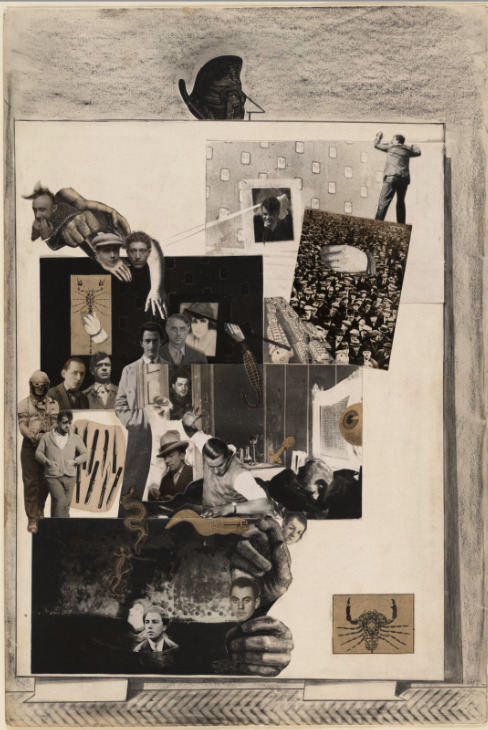
Hans Bellmer. Plate from La Poupée. 1936

Lee Miller, Portrait of Space, Nr Siwa, Egypt, 1937.

SITUATIONIST INTERNATIONAL (IS)
Were a revolutionary alliance of European avant- garde artists, writers and poets formed at a conference in Italy in 1957.
The Situationist International brought together experimental poetry, avant-garde art, and radical social criticism to explore new techniques of engagement in cultural protest and revolutionary praxis.
When the Situationist International was first formed, it had a predominantly artistic focus; Gradually, however, that focus shifted more towards revolutionary and political theory.
It was anti-capitalist, and left-leaning, but was also committed to the disruption of the hegemonic politics of Europe in the late 20th century through artistic praxis as well as political agitation. Although eventually fracturing, SI provided a blueprint for rebels and artistic dissidents still followed today.
The notion of "Spectacle", originally outlined by Guy Debord in various Situationist writings, is key to understanding both the conceptual underpinnings of SI and its enduring legacy. The idea of a permanently distracting and preoccupying spectacle, which obfuscates the oppressive nature of capitalism, has been adopted by artists, activists, critics and academics as a key philosophical concept in the current moment of late capitalism.
Although a collaborative and supposedly open movement, SI adhered relatively rigidly to the direction of Guy Debord and the key ideas and artistic strategies he identified. This is somewhat ironic, as it was actually the wider dissemination and public take up of their ideas that ensured their longevity long after the group fragmented.
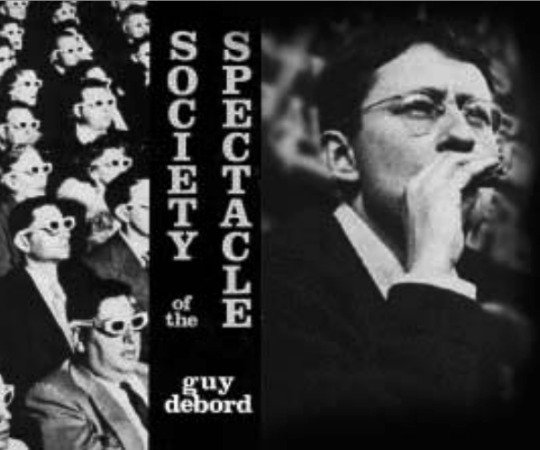
Asger Jorn experimented with spontaneous line and semi- figurative representation in paintings he called “modifications.” His works attempted to change people’s behaviours towards art, writing, and the spaces they lived in.
“A creative train of thought is set off by the unexpected, the unknown, the accidental, the disorderly, the absurd, the impossible”
Asger Jorn
Jorn was one of the few artists who identified themselves as Situationists during the main period of the movement’s activity but the political rhetoric surrounding the movement and it’s manifesto influenced the work of many future artists.
Asger Jorn, Modification with Brittany Woman, 1962.

Situationism as an art movement did not produce too many artworks as a matter of fact, with the exception of Asger Jorn, the movement’s output is next to none.
However, Situationism is credited with providing some of the most revolutionary theories at the time, concepts that heavily impacted the art scenes for decades.
Many of their game-changing ideas can still be found in today’s contemporary art.
The political background of SI influenced the evolution of music, Punk in particular. Also the political aspect of the movements is recorded as being instrumental in the origins of street art (graffiti), performance, and installation art.
Protests in Paris during May ’68
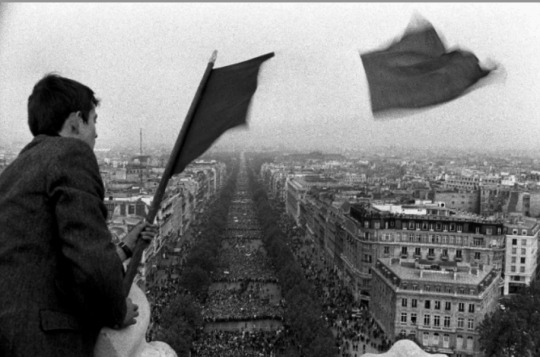
Peter Kennard, Haywain with Cruise Missiles 1981 & Defended to Death 1983


“Never Again’, Peter Kennard

Crushed Missile (1980) by Peter Kennard

Krzysztof Wodiczko, Hirschhorn Museum Washington DC 2018 and Projection on to South Africa House 1985
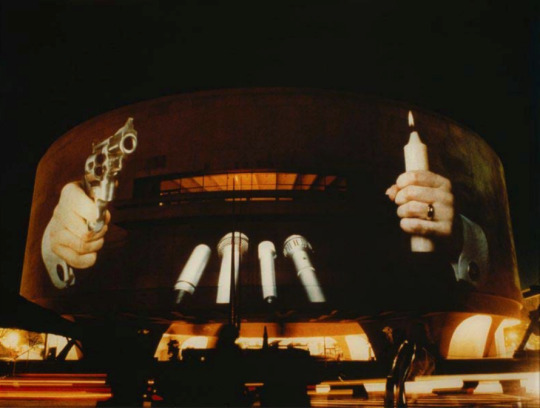
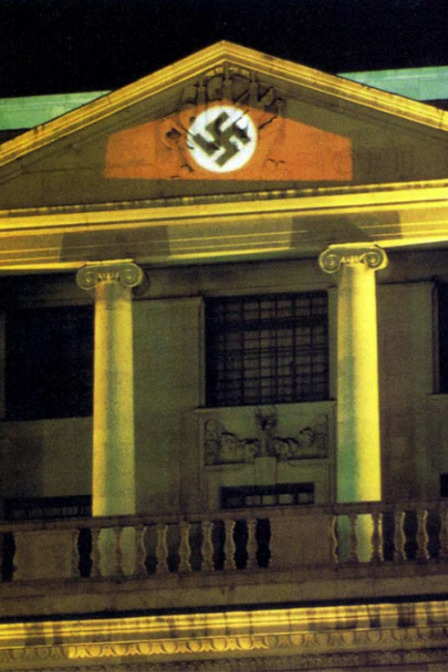
The Guerilla Girls, 1985-90
In 1984, a group of anonymous women, wearing gorilla masks, picketed the Museum of Modern Art in New York. MoMA was opening a show which purported to be a definitive survey of contemporary art, and yet out of the 169 artists featured in the show, only 13 were female. Since their inception, the group have worked to expose the under- representation of women in the art world by targeting galleries, art dealers and critics. Their manifesto comes in the form of their famous slogan artworks.
Guerrilla Girls, no title, 1985-90

Since their inception in 1984 the Guerrilla Girls have been working to expose sexual and racial discrimination in the art world, particularly in New York, and in the wider cultural arena.
The group’s members protect their identities by wearing gorilla masks in public and by assuming pseudonyms taken from such deceased famous female figures as the writer Gertrude Stein (1874-1946) and the artist Frida Kahlo (1907-54).
Guerrilla Girls, The Advantages of Being A Woman Artist, 1988

The Stuckist Manifesto, 1999
Established in 1999, the British group the The Stuckists proclaimed themselves to be “Against conceptualism, hedonism and the cult of the ego-artist.” The movement was formed by Billy Childish and Charles Thomson to celebrate and promote figurative painting in a reaction to the proliferation of conceptual art. Every year, the Stuckists famously demonstrate outside Tate Britain as the winner of the Turner Prize is announced.
1. Stuckism is the quest for authenticity.
2. Painting is the medium of self-discovery.
3. Stuckism proposes a model of art which is holistic.
4. Artists who don’t paint aren’t artists.
5. Art that has to be in a gallery to be art isn’t art.
The Stuckists, 1999
"Your paintings are stuck, you are stuck! Stuck! Stuck! Stuck!”
Tracey Emin
Billy Childish, Hand on Face, oil on canvas, 2000

Possibly the best-known recent example of an artistic manifesto in the digital age is that of The Stuckists – an art movement established in the UK 1999, which has now grown to at least 233 groups in 52 countries.
Its founding members, Billy Childish and Charles Thomson, rejected conceptual art, instead advocating a return to figurative paintings with ‘spiritual value’.
The success of this movement (members of which continue to demonstrate against The Turner Prize at London’s Tate Britain every year), has spurred other contemporary artists into creating their own manifestos. For example, The Resurrection Of Beauty, written by philosopher and photographer, Mark Miremont, calls for a rejection of what he describes as “The sarcastic relativism of dada”.
Outside the Turner Prize, Tate Britain, 2005: Stuckists demonstrate against the purchase of Chris Ofili's The Upper Room. The cutout is Tate chairman Paul Myners.
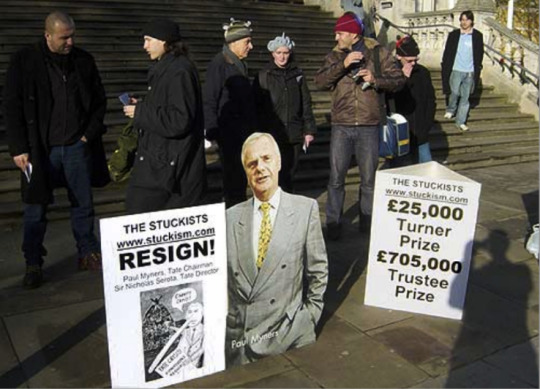
Manifestos within Photography
Brett Weston, Garden Apartment, New York

Group f/64
Formed in 1932, Group f/64 this group of so-called 'straight' photographers focused on the clarity and sharp definition of the un-manipulated photographic image. Committed to a practice of "pure photography",
Group f/64 encouraged the use of a large-format view camera in order to produce grain-free, sharply-detailed, high value contrast photographs. Group f/64 mounted a revolt against the dominant fashion within the art of photography which was to ape the painterly and graphic techniques associated with Bay Area Pictorialism. The members' preference was for a style of art photography that would fully promote the camera's unique mechanical qualities.
The original 11 members of Group f.64 were Ansel Adams, Imogen Cunningham, Edward Weston, Willard Van Dyke, Henry Swift, John Paul Edwards, Brett Weston, Consuelo Kanaga, Alma Lavenson, Sonya Noskowiak, and Preston Holder.
"Pure photography is defined as possessing no qualities of technique, composition or idea, derivative of any other art form." —Group f/64 Manifesto, August 1932
Dunes, Oceano, Edward Weston, 1936

Half Dome, Apple Orchard, Yosemite, Ansel Adams, 1933.

Two Callas, Circa 1925, Imogen Cunningham
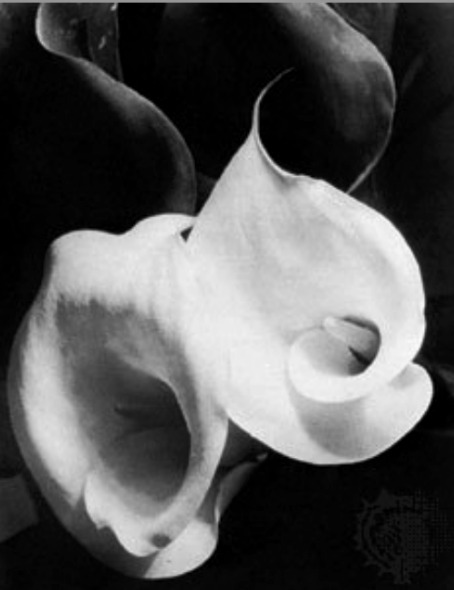
Group f/64 displayed the following manifesto at their 1932 exhibit:
The name of this Group is derived from a diaphragm number of the photographic lens. It signifies to a large extent the qualities of clearness and definition of the photographic image which is an important element in the work of members of this Group. The chief object of the Group is to present in frequent shows what it considers the best contemporary photography of the West; in addition to the showing of the work of its members, it will include prints from other photographers who evidence tendencies in their work similar to that of the Group.
Group f/64 is not pretending to cover the entire spectrum of photography or to indicate through its selection of members any deprecating opinion of the photographers who are not included in its shows. There are great number of serious workers in photography whose style and technique does not relate to the metier of the Group.
Group f/64 limits its members and invitational names to those workers who are striving to define photography as an art form by simple and direct presentation through purely photographic methods. The Group will show no work at any time that does not conform to its standards of pure photography. Pure photography is defined as possessing no qualities of technique, composition or idea, derivative of any other art form. The production of the "Pictorialist," on the other hand, indicates a devotion to principles of art which are directly related to painting and the graphic arts.
The members of Group f/64 believe that photography, as an art form, must develop along lines defined by the actualities and limitations of the photographic medium, and must always remain independent of ideological conventions of art and aesthetics that are reminiscent of a period and culture antedating the growth of the medium itself.
The Group will appreciate information regarding any serious work in photography that has escaped its attention, and is favourable towards establishing itself as a Forum of Modern Photography.
‘Magnum is a community of thought, a shared human quality, a curiosity about what is going on in the world, a respect for what is going on and a desire to transcribe it visually.’
Henri Cartier-Bresson
Behind the Gare Saint-Lazare, Henri Cartier-Bresson, 1932
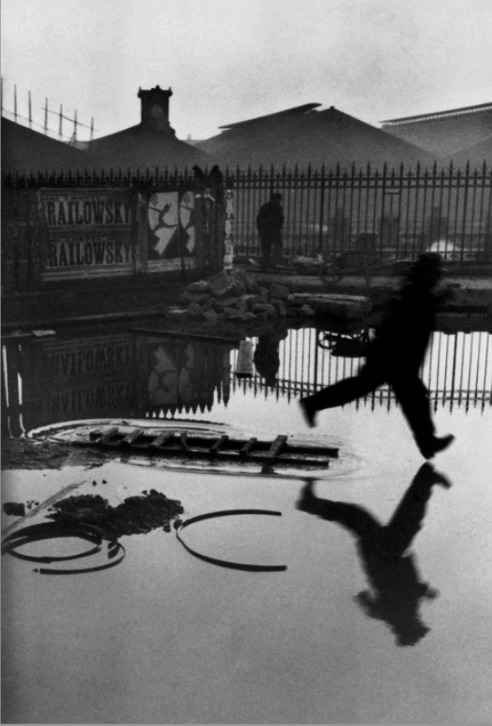
n 1947, following the aftermath of the Second World War, four pioneering photographers founded a now legendary alliance.
Combining an extraordinary range of individual styles into one powerful collaboration, Henri Cartier-Bresson, Robert Capa, George Rodger and David Seymour started, the most important artists’ cooperative ever created: The Magnum Photos agency.
Robert Capa US troops assault Omaha Beach during the D-Day landings (first assault), 1944.

“Capa was the boss because, for one thing, he kept on the lookout for stories for all the Magnum photographers. But equally vital were his experience, generosity, connections, aggressiveness, and the vision he had for Magnum, which kept us going. Since few of us were married, we had much time to spend together. We talked a lot, but rarely about photography. Our discussions were more often about politics or philosophy or racehorses, pretty girls, and money. We constantly looked at each other’s work, and criticism could be tough if the work did not measure up to the expected standard.”
Inge Morath
Magnum Photos represents some of the world’s most renowned photographers, maintaining its founding ideals and idiosyncratic mix of journalist, artist and storyteller. Our photographers share a vision to chronicle world events, people, places and culture with a powerful narrative that defies convention, shatters the status quo, redefines history and transforms lives. Magnum has documented most of the world’s major events and personalities since the 1930s; covering industry, society and people, places of interest, politics and news events, disasters and conflict.
Marc Riboud
An American young girl, Jan Rose Kasmire, confronts the American National Guard out the Pentagon durning the 1967 anti-Vietman march. (1967)

In planning the weekly news magazine, publisher Henry Luce circulated a confidential prospectus, within Time Inc. in 1936, which described his vision for the new ‘'Life'' magazine, and what he viewed as its unique purpose. ''Life'' magazine was to be the first publication, with a focus on photographs, that enabled the American public: “To see life; to see the world; to eyewitness great events; to watch the faces of the poor and the gestures of the proud; to see strange things — machines, armies, multitudes, shadows in the jungle and on the moon; to see man’s work — his paintings, towers and discoveries; to see things thousands of miles away, things hidden behind walls and within rooms, things dangerous to come to; the women that men love and many children; to see and take pleasure in seeing; to see and be amazed; to see and be instructed…”
On November 23, 1936, the first issue of the pictorial magazine Life is published, featuring the work of photographer Margaret Bourke-White.
Life was an overwhelming success in its first year of publication. Almost overnight, it changed the way people looked at the world by changing the way people could look at the world.
What the editors got from Bourke-White was a human document of American Frontier life & the photo essay format was born.
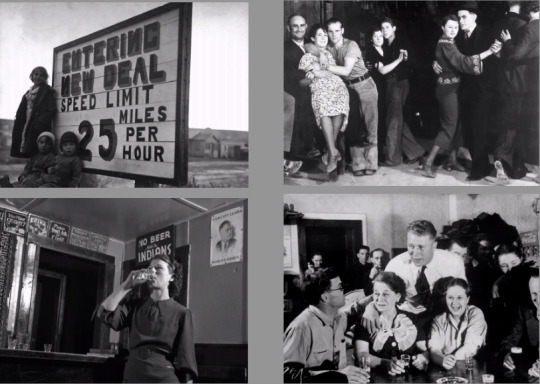
Photographer Margaret Bourke-White had been dispatched to the Northwest to photograph the multimillion dollar projects of the Columbia River Basin. What the editors expected were construction pictures as only Bourke-White could take them. What the editors got was a human document of American frontier life which, to them at least, was a revelation.”
(time.com)
Workers on Montana’s Fort Peck Dam blow off steam at night, 1936

Luce, and Life magazine gave photographers the opportunity to delve into the stories of extraordinary people with the magazine’s photo essay series format which endured for years.
Across a dozen pages, and featuring more than 20 of the great W. Eugene Smith’ pictures, the story of a tireless South Carolina nurse and midwife names Made Callen opened a window on a world that, surely, countless LIFE reader had never seen - and perhaps, had never even imagined.

Cindy Sherman Interview 2019
What are your three top tips for becoming an artist?
Try to forget everything you learned about making art. Find a group of like-minded artists or creative people to hang out with. Take chances with what you do, make things that no one but
you will ever see, unless it turns out so good you want to share it.
Why do you make art?
It’s my life and it’s what I’m most passionate about. And it’s fun!
What’s the best piece of advice you’ve ever been given?
Find inspiration in reading
Cindy Sherman, Untitled A 1967

Anthropcene
Anthropocene is a multidisciplinary body of work by Edward Burtynsky, Jennifer Baichwal and Nicholas de Pencier, which includes a photobook, a museum exhibition, a feature-length documentary film, and an interactive educational website.
The project’s starting point is the research of the Anthropocene Working Group, an international body of scientists who argue that the Holocene epoch ended around 1950, and that we have officially entered the Anthropocene in recognition of profound and lasting human changes to the Earth’s system.
The Holocene is the name given to the last 11,700 years of the Earths history- the time since the end of the last ‘ice age.’ Since then, there have been small-scale climate shifts notably the ‘Little Ice Age’ between about 1200 and 1700 A.D but in general, the Holocene has been a relatively warm period in between ice ages.
My earliest understanding of deep time and our relationship to the geological history of the planet came from my passion for being in nature.
Coal Mine #1, North Rhine, Westphalia, Germany, 2015

As a collaborative group, Jennifer, Nick and I believe that an experiential, immersive engagement with our work can shift the consciousness of those who engage with it, helping to nurture a growing environmental debate. We hope to bring our audience to an awareness of the normally unseen result of civilization’s cumulative impact upon the planet.
This is what propels us to continue making the work. We feel that by describing the problem vividly, by being revelatory and not accusatory, we can help spur a broader conversation about viable solutions.
We hope that, through our contribution, today’s generation will be inspired to carry the momentum of this discussion forward, so that succeeding generations may continue to experience the wonder and magic of what life, and living on Earth, has to offer”
Edward Burtynsky
Lithium Mines #1, Salt Flats, Atacama Desert, Chile, 2017

Gregory Crewdson is a photographer, but he calls himself a storyteller. He has spoken of his belief that “every artist has one central story to tell,” and that the artist’s work is “to tell and retell that story over and over again,” to deepen and challenge its themes. True to this, Crewdson’s most recent body of work, Cathedral of the Pines, shares the aesthetic that has defined his career”
Sylvie McNamara , Paris Review, 2016
The Shed, 2013, Cathedral of the Pines, Gregory Crewdson

The writers that are still influential to me are the writers that shaped me as I was coming of age as a young photographer. The ones I feel most aligned with would be, first and foremost, Raymond Carver and John Cheever. That brand of American realism. There are many more, but those are the ones I would say really shaped me in terms of storytelling.
Above all it’s their exploration of the ordinary, the familiar. I think with Carver in particular it’s the idea that you can find this sense of drama in a small domestic event, and it can be magnified and made transformative in some way. I see my pictures as being very much aligned with that, taking a familiar situation and making it dramatic, in my case through gesture and colour and light. And then, of course, giving the impression that everyday life is unsettled in some way, or made mysterious or wondrous somehow. I guess the story I most identify with is Cheever’s “The Swimmer.”
It’s realism meeting a psychological strangeness—it’s all located in a sort of familiar landscape and terrain, but it’s transformed. The irrational activity of swimming home through the neighbours' swimming pools is similar, in my mind, to the act of making the dirt piles in Close Encounters of the Third Kind. It’s that same attempt to find meaning in a world that feels alien, trying to make sense of a world that you feel disconnected from.
Gregory Crewdson
What is the purpose of an Artistic Manifesto in the 21st Century?
The Futurist manifesto was to provide the blueprint for many subsequent art movements, including the Dadaists, Surrealists and Situationists.
The document, published first in Italian newspaper Gazzetta dell’Emilia before being translated and appearing in French tabloid, Le Figaro, outlined the aims of this emerging art and social movement in dynamic, bold, revolutionary and often incendiary language.
Upon reading it, no-one was left in any doubt as to Futurism’s rejection of the past and its celebration of industry, precision, speed, youth and violence. As part of its vision for a better future, the manifesto advocated the modernization and complete cultural rejuvenation of Italy.
Since then, the artistic manifesto has lived on, even though other ways of broadcasting ideas began to become more prominent. In the 21st century, and the manifesto is enjoying something of a renaissance among artists, thanks in no small part to the advent of the internet and the opportunity of reaching large numbers of people more easily than ever before.
The Holstee Manifesto
The manifesto began as the guiding ideas behind Dave and Mike Radparvar's company, Holstee, which was launched in the summer of 2009 after quitting their corporate jobs. The brothers, along with their friend Fabian Pfortmüller, wanted to start a business that gave back and incorporated their social and environmental values.
To be sure, they were clear about what they were doing with their new company when they wrote the manifesto and published it on their site.
“Mike and I sat down with our best friend and co-founder, Fabian, to reflect and write down why we were starting Holstee. We sat on the steps of Union Square in New York City and, together, defined what success would look like. Not the typical kind of success — based on extrinsic motivators like wealth or status — but a different kind, based intrinsic motivators like putting energy into things that feed our soul and spending time with the people we care about.
Dave Radparvar.
The document has been viewed online more than 50 million time and translated into 12 languages. When Holstee turned the message into a $25 poster - printed on recycled paper, it became one of the company’s top sellers.
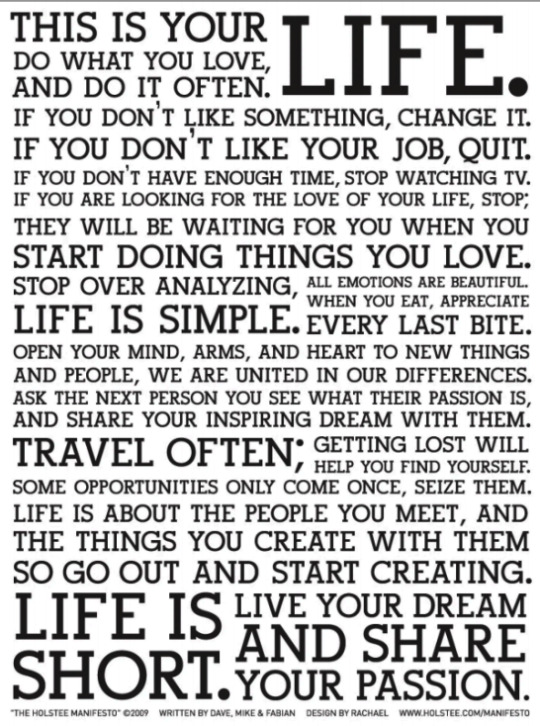
The Holstee Manifesto - Life Cycle
youtube
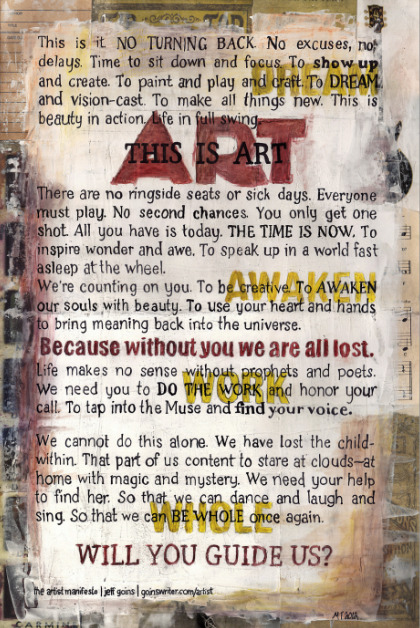


WRITING YOUR OWN MANIFESTO
A manifesto is a declaration of aims and policy
This task asks you to articulate and commit to a statement regarding your work in that arts and its intent
Ask yourself the question, ‘What do you believe?’
0 notes